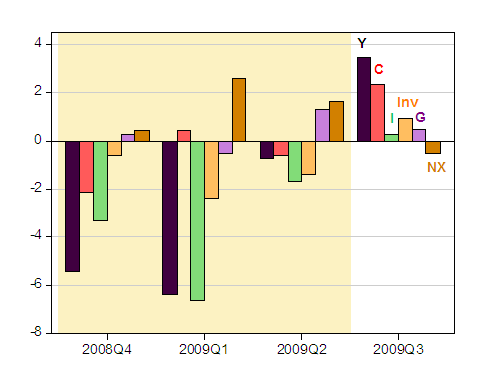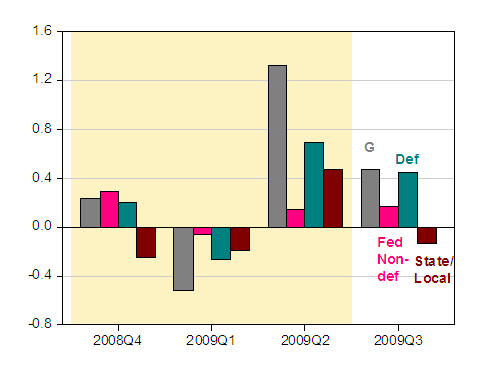The 3.5% growth rate was, in my view, in large part attributable to direct measures to stimulate the economy, including direct spending on goods and services by the government (Federal, state and local), as well as tax measures. First, let’s take a look at how each category of final demand accounted for total growth, in the context of a mechanical decomposition, in Figure 1.

Figure 1: GDP growth and contributions to growth of GDP, in ppts; GDP (black), consumpion (red), fixed investment (green), inventory investment (orange), government consumption (purple), and net exports (light brown). Non-shaded area denotes 2009Q3 advance release. Source: BEA, 2009Q3 advance release, October 29, 2009.
Figure 1 breaks down the contributions of overall growth into the broad national income accounting components (overall investment decomposed into fixed and inventory investment). Interestingly, the contribution of government is fairly modest in Q3 (Note change of vertical axis scale).

Figure 2: Government contributions to growth of GDP, in ppts; total government (gray), Federal non-defense(pink), defense (teal), and state and local (brown). Non-shaded area denotes 2009Q3 advance release. Source: BEA, 2009Q3 advance release, October 29, 2009.
Figure 2 breaks down the government consumption growth contribution into that from Federal nondefense, defense, and state and local government.
Government spending on goods and services (not overall government expenditures) accounted for 0.48 percentage points (ppts). Federal nondefense expenditures accounted for 0.17 ppts, while defense accounted for 0.45 ppts. State and local spending accounted for negative 0.14 ppts. At this juncture, one could leap to the conclusion that the stimulus package, and other measures, had no effect on output. And I’m sure many will. But I think it pays to be a bit circumspect in this regard.
First, it’s always helpful to recall that the advance estimate incorporates lots of estimates, and is subject to revisions (see this post).
Second, some individuals have argued that since a portion of the government component comes in the defense category, that should not be construed as being attributable to the stimulus package. But in point of fact, according to CRS ARRA does have some defense expenditures (mostly energy efficiency upgrading). One can see what contracts have been let by going to the http://www.Recovery.gov website (noncompetitive contracts here). As an open question, I’m not sure where Army Corps of Engineers expenditures fall in the categories (I think it’s under defense as well, in which case the defense category would incorporate even more of the stimulus spending).
Third, the decline in state and local government spending’s contribution is notable. Given the big budget shortfalls in state budgets [1], what this outcome tells me is in the absence of the transfers from the Federal government, the negative contribution would have been even larger.
The Joint Economic Committee held hearings today; J Steven Landefeld, the head of the BEA, stated in his testimony:
…let me conclude by describing how it is reflected in GDP and the national accounts. BEA’s national accounts include the effects of the federal outlays and tax cuts included in the ARRA. Because most of the outlays and tax reductions from ARRA during the last three quarters were in the form of grants to state and local governments, tax reductions for individuals and businesses, and one-time payments to retirees, their effects on GDP show up indirectly through the effects on GDP components such as consumer spending, residential investment, and state and local government spending. Thus, BEA’s accounts do not directly identify the portion of GDP expenditures that is funded by ARRA. During each of the second and third quarters, the Making Work Pay Credit lowered personal taxes and raised disposable personal income about $50 billion (annual rate). During the second quarter, ARRA provided payments of $250 to beneficiaries of social security and other programs that raised disposable personal income about $55 billion. ARRA also provided special government benefits for unemployment assistance, for student aid, and for nutritional assistance; these special benefits raised disposable income about $49 billion in the third quarter and about $35 billion in the second quarter. ARRA also funded grants (such as Medicaid) and capital grants (such as highway construction) to state and local governments of about $75 billion in the third quarter and $85 billion in the second quarter.
Mark Zandi also testified. His testimony included this interesting table, reporting estimates of expenditures.

Table 2 from Zandi .
Zandi writes:
Criticism that only $175 billion of the $787 billion stimulus plan has been distributed through tax cuts and increased government spending is misplaced (see Table 2). What matters for economic growth is the pace of stimulus spending, which surged from nothing at the beginning of the year to about $80 billion in the third quarter. That is a big change in a short period and is why the economy is growing again after more than a year.
A competing view is presented by Kevin Hassett (of Dow 36,000) in his testimony.
I think FED have the incentive to devalue US dollar to improve the trade imbalance and stimulate the economy together but they cannot explicitly express. Surely, they want to see orderly massive dollar depreciation.
They will stop monetary stimulus when the unemployment is back to natural level and the current account deficit goes to positive. I think this is the right policy but surely this will create the upward surprise in inflation at the end; thats why many FED members start to show hawkish idea to suppress the inflation expectation. That is also right policy and actions. However, at the end the public will realize this strategy and the inflation will come and a lot of speculation in financial assets will occur. We will have to see the effective policy because I think if the economy is back to normal and the dollar devalue enough, the FED will tackle the speculation in the market in the case that the speculation cause the change in macroeconomic trend.
Now the speculation is at the beginning with cash or credit; surely this speculation is not creating the severe effect and cannot change the macroeconomic picture but at the end the speculation from credit will come. I think FED will improve the regulation and system to tackle the speculation in the market rather than using the monetary policy at first and if it is prominent to affect economy, they will tighten the policy.
I also think fiscal and monetary policies should be big at first to bring the unemployment back to the natural rate as quickly as possible and the cost of stimulus is low. But after the economy is back to normal, the long term policy to improve the productivity and to reform the structure imbalance is the must to sustain the economy.
We are not into the normal so the long way to go and the risk is too low for stimulus policy.
Also, the big jump in C in attributable, in part if not in whole, to tax cuts and cash-for-clunkers. Perhaps even more than 100% of the observed increase in C is due to ARRA, since C might have declined if there had been no stimulus.
The problem as always is figuring out what the default scenario would have been. Looking at the changes from the previous quarter is interesting, but can’t definitively answer the question of the effectiveness of ARRA.
How about a breakdown of each of the GDP components into those financed with debt and those financed “non-debt”?
Zandi: “What matters for economic growth is the pace of stimulus spending, which surged from nothing at the beginning of the year to about $80 billion in the third quarter”.
Well, if that is the case, then why did we need a $787 billion stimulus plan? Perhaps one a quarter that size, or at most half, would have been sufficient.
Monetary policy operates with long and variable lags: Do you think the decision to cut rates to near-zero and grow M2 had much influence on this quarter’s growth?
I do. As I said in our MoneyWatch debate back in March: “Money growth takes a year or two to help the economy, but help is already on the way.”